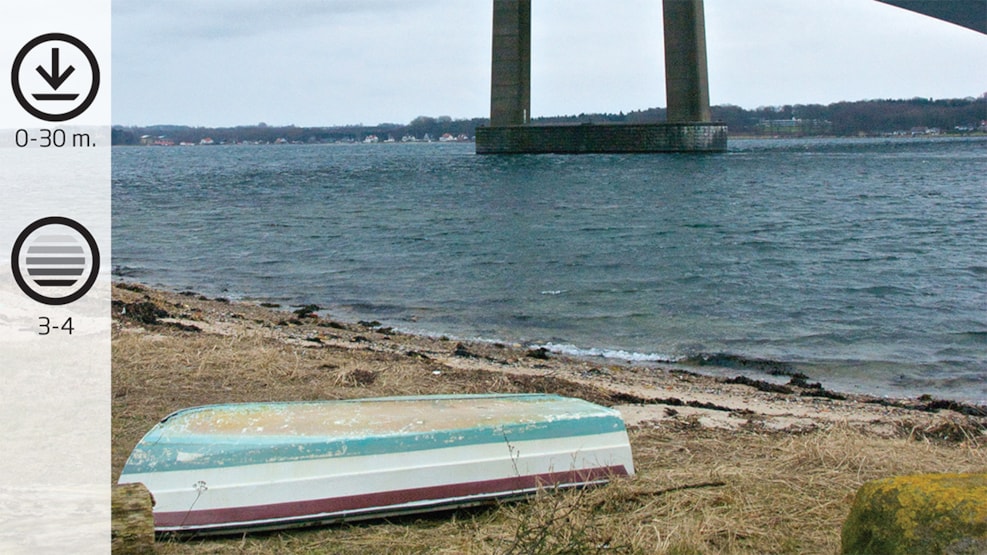
Lyngsodde
Danish California - large areas of upright laminaria hyperborea. Small wall with caves which hide yarells blenny, butterfish and other cave living fish. Chance to experience the great cod.
Facts:
How to find Coming from E20, take Exit 59 and turn right at Snoghøj Landevej. Then turn left at Vesterballevej, which becomes Lyngsoddevej. You reach the parking space at the end of Lyngsoddevej.
Geocoordinates:
Longitude: 9.7409515321
Latitude: 55.519301841
Google Earth Coordinates:
Latitude: 55°31'9.06"N
Longtitude: 9°44'28.27"Ø
Getting in and up the water: You can enter the water in front of the parking space, but do not start your dive, until you reach the bridge.
Highlights: Upright laminaria hyperborea and the varied animal life – especially during winter months
Air filling station: You can get your airbottle refilled at Hindsgavl Camping in Middelfart (open all year round) during opening times. Alternatively ask the local diving club in Middelfart, Tel.: +45 3311 1323 : Dykkerklubben Marsvinet
Best season: All year round
Dangerous areas: Do not get out of the belt and make sure the clearly marked with 'A' flag. Sailing close to the shore occurs throughout the year.
Depth: 0- 30 M.
Tide: Be careful not to get too far into the belt. The tide can be strong.
Level of difficulty (1-5): 3-4
Permissions: None
Facilities: Parking space and toilet
Photo opportunities: Wide angle and macro
Lyngsodde
When you stand under the New Lillebælt Bridge and is ready to dive you can rejoice. For this it is really good dive. The dive is called for Danish California by local divers, because of the large area with upright laminaria hyperborea.
You start the dive east of the parking area, underneath the bridge and immediately the large laminaria hyperborean belt opens up. Keep a straight course out in the belt towards the bridge pier and after some swimming, where it slopes down to 7 metres depth, you reach a wall which is a few metres high. This is beautifully overgrown and near the seabed you can find some smaller and bigger caves.
Yarells blenny, butterfish and other cave living fish hide here - also the big cod. Swim to the right along the wall and follow this until it flattens out. From here, swim out into the belt again and if the sight is reasonable, you can already see the three pillars. They are as far as known, remains from the construction of the bridge and stand at 14 to 16 metres depth. Beautiful wide-angle images are possible, when the visibility is right.
After a swim around the pillars, you can proceed further into the belt at a slanted course towards south. Here you will at 22 metres depth find the light clay seabed which looks like a big Swiss cheese with the many holes. Here are often some flounders. The wall reappears when you swim towards the shore. On this stretch you can observe the layering of the light and the dark clay. If you are lucky you will, at approx. 12 metres depth, meet the remains of a large net as well as something that looks like a barge. There are good chances to see large cod.
Further towards the shore you come back over large belts of sugarkelp and laminaria hyperborea. If you dive in winter, there are many nudibranch too. They are found here in large numbers in the coldest months of the year. They turn to the shallow water to breed and eat polyps. Most of the species that live in Danish waters you can find here.
The seabed is very varied and around the many large brown algae there are many hiding places for smaller fish such as butterfish, threespine sticklebacks and gobies. Further out in the belt you find slightly larger rocks, which are nicely overgrown with different red seaweed, plumose anemones and breadcrumb sponge. You will also find sea anemones in large sizes at the seabed and on the rocks.
It is clear that this is one of the most tidal-filled places in Snævringen, as the size of the filtering animals is very large and especially the large brown algae are huge. All the animals that are associated with life on a stone reef are found here, both small and large. The wide variation in depth, seabed and animals is the highlight of the spot.
This is one of the best diving spots in Snævringen.